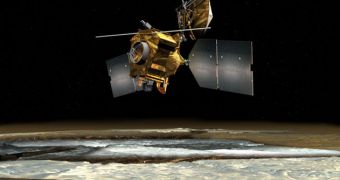Experts at NASA announce that their largest Martian orbiter has recovered from the computer glitch that impaired its operations a few days ago.
At the time, a malfunction in the computer systems aboard the Mars Reconnaissance Orbiter forced the spacecraft to go into safe mode for the fifth time in just two years.
This large incidence of glitches hints that something is wrong with the robot's computer. But, even if experts managed to make the craft bounce back from its predicament each time, they had no luck in making the errors go away altogether.
Officials at the NASA Jet Propulsion Laboratory (JPL), which manages the MRO flight, say that they managed to make the computers reboot on Saturday, September 18, just three days after the spacecraft reported being impaired.
The instruments onboard the robotic explorer began collection data immediately afterwards, which is the main goal mission controllers were striving for.
The MRO houses the High Resolution Imaging Science Experiment (HiRISE) camera, which is probably one of the best imaging devices ever sent to another planet or moon.
The amount of details that HiRISE images include make it the ideal choice in tools for determining the landing site for the next NASA mission to Mars, the rover Curiosity.
It is estimated that, in the roughly 5 years since MRO has been orbiting the Red Planet, its cameras have imaged more than 1 percent of the entire planet's surface, which a very large surface.
But, ever since launch, the explorations robot has been plagued by misfortune, experiencing a variety of glitches in its instruments and computer systems.
The latest instance took place after MRO's computers spontaneously rebooted for unknown reasons on September 15, sending its JPL engineers into a frenzy.
Eventually, the experts were able to compensate for the error, and to make the computers come back to life again. They worked around the clock to achieve this.
The MRO is currently in its mission extension phase, having already completed the primary science phase of its operations in November 2008.
At this time, it is operating as a science platform and communications relay, which is being used by the Spirit and Opportunity rovers to contact Earth without having to use their energy-consuming, high-gain antennae, Space reports.

 14 DAY TRIAL //
14 DAY TRIAL //